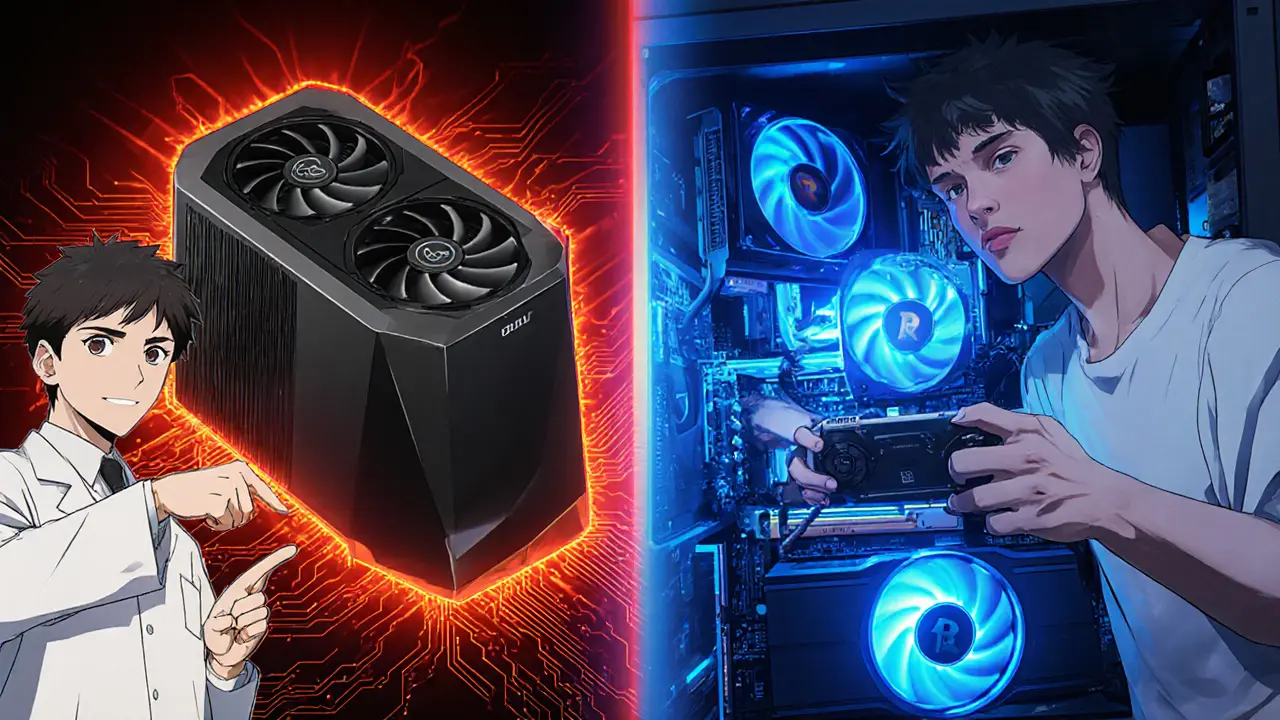Cryptocurrency Mining Profitability Calculator
Estimate your potential daily profit from mining. Enter your mining setup details below to calculate profitability.
Estimated Daily Profit
Daily Earnings:
$0.00
Monthly Earnings:
$0.00
How This Calculator Works
This calculator estimates daily profits using the formula:
Profit per day = (Hash Rate × Reward × Price) - (Power (W) / 1000 × kWh Cost × 24)
Assuming a standard Bitcoin block reward of 6.25 BTC, converted to USD using the provided coin price.
When you hear about cryptocurrency mining, you probably picture rows of humming machines turning electricity into digital cash. In reality, mining is a clever way to keep a blockchain honest while slowly releasing new coins. This guide breaks down what mining does, the gear you need, and whether it makes sense for you to start.
Key Takeaways
- Mining validates transactions and creates new coins through a proof‑of‑work puzzle.
- Hardware ranges from graphics cards (GPUs) to specialised ASICs, each with different efficiency.
- Profitability hinges on electricity cost, hardware price, and the current coin price.
- Mining pools spread rewards, while solo mining offers full payouts but high variance.
- Environmental impact and regulatory rules are shaping the future of mining.
Cryptocurrency Mining is the computational process that validates transactions on a blockchain and introduces new digital coins into circulation. It runs on the proof‑of‑work (PoW) consensus model, meaning miners must solve a difficult mathematical puzzle before a block is added to the chain. The first solver earns newly minted coins and any transaction fees included in that block.
How Mining Actually Works
Every transaction first lands in a temporary holding area called the mempool. Miners pick transactions-usually those with the highest fees-to build a candidate block. A block header contains five essential pieces: the previous block’s hash, a Merkle Root is a single hash that represents all transactions in the block, a timestamp, the network’s current difficulty target, and a nonce that miners tweak.
Miners repeatedly hash this header using the SHA‑256 algorithm (for Bitcoin). The goal? Produce a hash that starts with a certain number of zeros, dictated by the difficulty target. Because hash functions are unpredictable, miners must try countless nonce values-sometimes quintillions per second-until they hit a winning hash.
When a miner finds a valid hash, the block propagates through the Blockchain is a distributed ledger where each block links to the previous one, forming an immutable chain. Other nodes verify the solution, add the block to their copy of the chain, and the miner receives the block reward plus fees.
Core Components of a Mining Setup
Successful mining relies on four pillars: hardware, software, a wallet, and a pool (optional).
Hardware
There are three main types of mining hardware, each with its own trade‑offs.
| Hardware | Typical Hash Rate (GH/s) | Power Consumption (W) | Cost (USD) |
|---|---|---|---|
| GPU (e.g., RTX 4090) | ~120 | ~350 | ~1,600 |
| ASIC (e.g., Bitmain Antminer S19 Pro) | ~110,000 | ~3,250 | ~5,500 |
| CPU (generic) | ~0.05 | ~65 | ~200 |
GPUs are flexible-you can switch them between Bitcoin, Ethereum (while it was PoW), and many altcoins. ASICs, on the other hand, are custom‑built for a single algorithm, delivering massive speed but no versatility.
Software
Mining software connects your hardware to the network or a Mining Pool is a group of miners who combine hash power and share rewards proportionally. Popular options include CGMiner, BFGMiner, and NiceHash. The software handles work distribution, hash submission, and payout tracking.
Wallet
After a block is solved, the reward is sent to a crypto Wallet is a digital tool that stores private keys and lets you receive, send, and manage cryptocurrencies. For mining newbies, a simple web wallet or a hardware wallet (like Ledger) works fine.
Mining Pools vs. Solo Mining
Solo mining means you keep every reward, but the odds of solving a block on your own are slim unless you run a large ASIC farm. Pools aggregate many miners’ hash power, so you earn smaller, steadier payouts. Most beginners start with a pool to smooth out income.

Mining Economics: Difficulty, Rewards, and Profitability
Two dynamic factors keep the system balanced: Difficulty is the network-adjusted measure that determines how hard it is to find a valid block hash and the block reward. Every ~10 minutes, Bitcoin’s protocol recalculates difficulty based on total network Hash Rate is the total number of hashes computed by all miners per second. More hash power → higher difficulty → longer time to solve a block, keeping the block interval steady.
Bitcoin’s reward started at 50BTC and halves roughly every four years (the “halving”). The latest halving in 2024 cut the reward to 6.25BTC, which affects profitability. Miners now rely more on transaction fees as an extra income stream.
To estimate profit, you need three numbers: hardware cost, electricity price (kWh), and the coin’s market price. A simple formula is:
Profit per day = (Hash Rate × Reward × Price) - (Power (W) / 1000 × kWh Cost × 24)Running this calculator with current data tells you whether a GPU rig or an ASIC makes sense for your location.
Environmental Impact and Regulation
Proof‑of‑work demands a lot of electricity-global Bitcoin mining consumes roughly 120TWh annually, comparable to a small country’s power use. This has sparked debates about carbon footprints and led some governments to ban or tax mining operations. On the flip side, many farms now locate near renewable energy sources (hydro, wind) to lower costs and emissions.
Regulators also watch for centralisation. A few large Mining Pools control a significant share of the network’s hash rate, raising concerns that a single entity could theoretically perform a 51% attack.
Getting Started: Step‑by‑Step Guide
- Choose a coin. Bitcoin is the most famous, but other PoW coins like Litecoin or Zcash may be easier for beginners.
- Calculate profitability. Use an online mining calculator, input your hardware’s hash rate, power draw, electricity cost, and the coin’s price.
- Buy the hardware. For Bitcoin, an ASIC like the Antminer S19 is standard. For altcoins, a modern GPU (RTX 4090) works well.
- Set up cooling. Mining rigs generate heat; ensure proper ventilation or liquid‑cooling to avoid throttling.
- Install mining software. Follow the software’s guide to link your hardware to a pool and enter your wallet address.
- Monitor performance. Track hash rate, temperature, and earnings. Adjust settings if you see excessive power use.
- Stay informed. Keep an eye on network difficulty, upcoming halving events, and regulatory news in your region.
Remember, the initial investment can take months to pay off, especially if electricity rates are high. Some hobbyists treat mining as a learning experiment rather than a profit‑making venture.
Common Pitfalls and Pro Tips
- Don’t ignore electricity costs. In the UK, residential rates can make mining unprofitable unless you have a low‑tariff plan.
- Avoid over‑clocking without adequate cooling; it shortens hardware lifespan.
- Choose reputable pools. Some pool operators take higher fees or have slow payout schedules.
- Keep firmware updated. Firmware updates often improve hash efficiency and security.
- Consider future upgrades. ASICs become obsolete quickly as newer models improve hash‑per‑watt ratios.

Frequently Asked Questions
What exactly does a miner do?
A miner gathers pending transactions, assembles them into a block, and repeatedly hashes the block header until the result meets the network’s difficulty target. When successful, the block is added to the blockchain and the miner receives new coins plus any fees.
Is mining still profitable in 2025?
Profitability depends on three factors: hardware efficiency, electricity price, and the current market value of the coin. In regions with cheap renewable power, ASIC farms can still earn a margin, but hobbyist GPU mining of Bitcoin is generally unprofitable today.
Can I mine Bitcoin with a regular computer?
Technically you could, but a CPU or old GPU would never solve a block before the difficulty makes it impossible. The network’s hash rate is dominated by ASICs, so solo mining on a conventional PC would yield no rewards.
What is the difference between a mining pool and solo mining?
In a pool, many miners combine their hash power and split any reward proportionally, giving steady, smaller payouts. Solo mining means you keep the entire block reward, but the chance of finding a block is extremely low unless you control a massive amount of hash power.
How does mining affect the environment?
Proof‑of‑work mining burns a lot of electricity, which can lead to high carbon emissions if the power comes from fossil fuels. Many operators now locate near hydro or wind farms to cut both costs and their carbon footprint.


Post Comments (24)
Hey everyone! 😊 Thanks for checking out the mining guide – it’s a crazy mix of tech and economics. If you’re just getting started, remember that electricity costs are often the biggest hole in your wallet. A good rule of thumb is to run the profitability calculator with your local kWh rate before buying any hardware. Also, keep an eye on the network difficulty; it can creep up faster than you think. Feel free to drop any questions, I’ll try to help out! 🙌
While the guide’s tone is welcoming, let’s not gloss over the fact that PoW mining is fundamentally a zero‑sum energy sink. The ASIC throughput per watt ratio has plateaued, making marginal gains more speculative than revolutionary. Moreover, difficulty adjustments neutralize any short‑term hash spikes, so “run the calculator” is practically a tautology. 😏 If you’re chasing ROI, consider the thermodynamic entropy costs before any marginal hash rate improvements.
Sure, let’s just dismiss the whole hobbyist angle because “energy sink” sounds impressive in a conference abstract. Yet countless small‑scale miners still contribute a non‑trivial share of network hash, especially in regions with abundant hydro power. Ignoring those pockets paints an incomplete picture, even if the jargon feels a bit over‑engineered.
The act of mining mirrors a modern Sisyphean task-pushing computational boulders uphill only to watch them roll back into the ether. One might argue that the pursuit is less about profit and more about the existential affirmation of participation in a decentralized ledger. Yet, the relentless drive for efficiency raises ethical questions about resource allocation in a world of scarcity.
That’s a profound way to view it. For anyone inspired to join, start small, calculate your power usage, and scale responsibly. Energy‑efficient setups can coexist with sustainability goals when managed wisely.
Honestly, most of this is just hype 🤷♂️
It is imperative to recognize that the romanticization of cryptocurrency mining obscures its inherent environmental externalities. The moral responsibility lies with investors to demand transparent carbon accounting from mining operations. Without such scrutiny, we perpetuate a cycle of ecological degradation under the guise of technological progress.
Look, Mark, you sound like a textbook lecturer while the planet burns. Your moral grandstanding doesn't change the fact that many miners are already shifting to renewable sources. Stop preaching and start acknowledging the real strides being made.
So you think the whole thing’s a hype train? Yeah, I’ve seen the same buzz around every new tech fad, but the data shows a niche yet growing community actually making steady gains.
It’s true, trends come and go, but if you calculate the ROI with local electricity rates, you’ll see whether it’s viable for you.
Wow, another deep dive into mining, because we totally needed more math in our lives 🙃. If you love watching numbers dance while your electricity bill spikes, this is the perfect weekend hobby. Just remember to smile when the ASICs hum louder than your neighbor’s karaoke sessions.
Indeed; while the allure of hash‑rate accumulation is compelling, one must not overlook the opportunity cost; time spent calibrating rigs could be allocated to more intellectually stimulating pursuits!!! Nevertheless, the pursuit remains a testament to human ingenuity in decentralized consensus protocols.
Mining, in its essence, is a paradoxical blend of relentless computation and fragile economics. The first sentence sets the stage for a discourse on the nature of proof‑of‑work, inviting contemplation about the cost of security. Second, we must acknowledge that each hash operation consumes energy, which translates directly into carbon footprints that society cannot ignore. Third, the profitability equation is not merely binary; it fluctuates with market sentiment, hardware depreciation, and regional electricity tariffs. Fourth, the hardware lifecycle plays a crucial role, as ASICs become obsolete within months due to incremental efficiency gains. Fifth, the cryptographic difficulty adjusts algorithmically, ensuring block times remain stable despite fluctuating total hash power. Sixth, miners collectively safeguard transaction integrity, thereby earning the privilege to mint new coins-an incentive mechanism rooted in game theory. Seventh, the societal impact extends beyond finance, influencing geopolitical dynamics as nations vie for energy resources. Eighth, diversification into alternative consensus models, such as proof‑of‑stake, challenges the long‑term relevance of mining. Ninth, the environmental narrative is increasingly shaping regulatory frameworks that could impose carbon taxes on mining farms. Tenth, investors must therefore perform multidimensional risk assessments, incorporating both technical and regulatory variables. Eleventh, community discourse often overlooks the nuanced trade‑offs between decentralization and efficiency. Twelfth, educational outreach can demystify misconceptions that mining is exclusively a speculative gamble. Thirteenth, real‑world case studies of renewable‑powered farms demonstrate viable pathways toward sustainable mining. Fourteenth, the convergence of AI‑driven optimization and hardware engineering promises incremental gains in hash‑per‑watt ratios. Fifteenth, nevertheless, the law of diminishing returns looms large, cautioning against unchecked scaling. Finally, the philosophical question persists: does the pursuit of digital scarcity justify the tangible costs incurred upon our planet?
Whoa, that was a novel-did you need a coffee break after that paragraph marathon? 🙄
You’ve all shared great points. Keep tracking your power usage and stay realistic about expectations. Consistency beats hype any day.
I agree, staying realistic helps a lot. It’s easy to get caught up in excitement, but a clear plan makes mining more manageable.
Hey guys, love the deep dives! 😄 I’m kinda new but this stuff is super interesting, even if my brain feels fried after reading all the tech talk.
Don’t worry you’ll get the hang of it soon keep learning and stay positive
Honestly, the whole mining conversation feels like a modern quest for meaning-pushing for digital gold while questioning our impact on the earth.
Sure, but don’t forget the hidden agendas-big tech firms are pulling strings behind the scenes, and the true cost is being kept secret from the public.
Enough of the wishy‑wash. If you want profit, get a proper ASIC, cheap power, and stop reading endless theory.
While decisive action is important, I’d still encourage a thorough cost‑benefit analysis before committing large capital. Informed decisions lead to sustainable success.
The allure of mining is a siren song-bright promises that fade once the bills arrive.
Exactly! Picture a glittering treasure chest that, once opened, reveals a maze of cables, humming fans, and the relentless glow of LED panels. The excitement of unlocking new blocks can feel like discovering hidden realms, yet each triumph is shadowed by the whisper of power meters ticking up. To truly master this craft, you must balance the poetry of decentralization with the gritty arithmetic of kilowatt‑hours. Embrace the vibrant community, learn from seasoned miners, and let your curiosity guide you through the labyrinth of hardware upgrades and software tweaks. In the end, the journey itself becomes as rewarding as the coins you harvest.